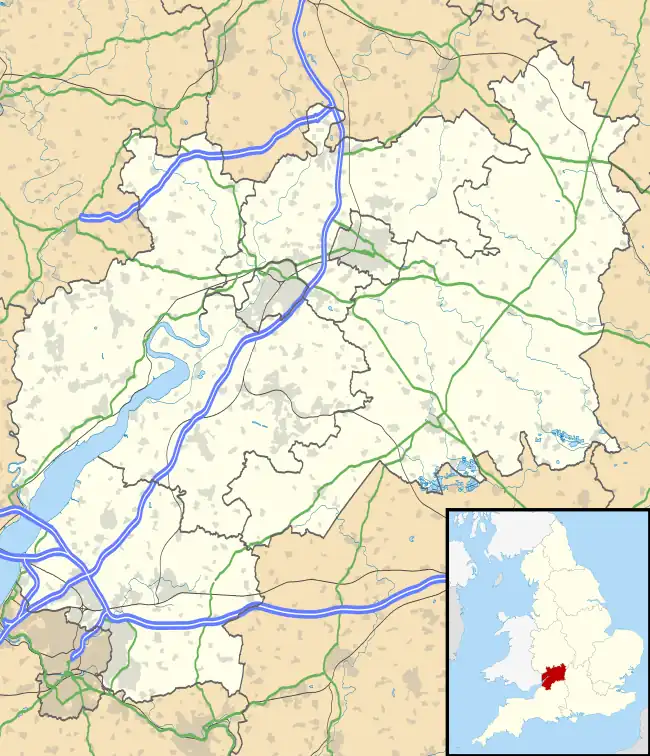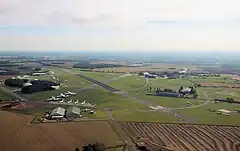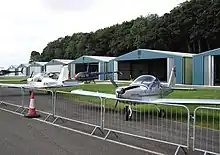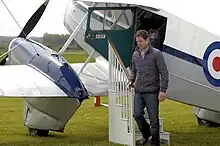Cotswold Airport
Cotswold Airport (IATA: GBA, ICAO: EGBP) (formerly Kemble Airfield) is a private general aviation airport, near the village of Kemble in Gloucestershire, England. Located 4.5 NM (8.3 km; 5.2 mi) southwest of Cirencester, it was built as a Royal Air Force (RAF) station and was known as RAF Kemble. The Red Arrows aerobatics team was based there until 1983. Since 2000, it is used for the storage and recycling of retired airliners, as well as flying schools, clubs, and industry.
Cotswold Airport | |||||||||||||||
|---|---|---|---|---|---|---|---|---|---|---|---|---|---|---|---|
 Cotswold Airport control tower | |||||||||||||||
| Summary | |||||||||||||||
| Airport type | Private | ||||||||||||||
| Owner | Ronan Harvey | ||||||||||||||
| Operator | Kemble Air Services Limited | ||||||||||||||
| Location | Cirencester | ||||||||||||||
| Elevation AMSL | 436 ft / 133 m | ||||||||||||||
| Coordinates | 51°40′05″N 002°03′25″W | ||||||||||||||
| Website | www | ||||||||||||||
| Map | |||||||||||||||
 EGBP Location in Gloucestershire | |||||||||||||||
| Runways | |||||||||||||||
| |||||||||||||||
Cotswold Airport is clear of controlled airspace, allowing free movement for training aircraft. It is centrally positioned between Cheltenham, Gloucester and Swindon. The nearest railway station is at Kemble.
History
RAF Kemble
Construction work for RAF Kemble began in 1936, and the first operational unit to arrive at the station was No. 5 Maintenance Unit on 22 June 1938. In 1940, No. 4 Service Ferry Pool moved to the station from Cardiff, and Kemble became one of the main bases for the aircraft ferrying operations of the Air Transport Auxiliary in this region of the British Isles. Around the same time, Kemble was also the home of No. 1 Overseas Aircraft Preparation Unit (OAPU).[2]

From 1966 until 1983, Kemble housed the Red Arrows, the RAF's aerobatic display team, which operated Folland Gnats and BAe Hawks.[3] After the Red Arrows moved to RAF Scampton, the station was used by the US Air Force as a maintenance facility, initially for Fairchild Republic A-10 Thunderbolt II aircraft, followed by Northrop F-5s, McDonnell Douglas F-15 Eagles, Lockheed C-130 Hercules and Boeing KC-135 Stratotankers.[2]
Following the end of the Cold War, the US Air Force left the station and it was returned to the Ministry of Defence (MoD) on 31 March 1992 with airfield operations stopping. The Royal Air Force withdrew on 31 July 1992. The British Army made use of the site to store surplus vehicles and equipment.[4]
Civilian use
The MoD initially leased buildings on the former station before selling the site to Ronan Harvey, a local businessman, in March 2001.[2] As of 2023, Harvey retains ownership through his company Cotswold Airport Holding Co Limited, and his daughter Suzannah Harvey is a director of two subsidiaries, Kemble Airfield Estates Limited and Kemble Air Services Limited.[5] In 2021, she was described as CEO of the airport.[6][7]

There was a threat of closure because of a mistake which Cotswold District Council made relating to planning permission when it was sold by the MoD. However, this is no longer the case, and the planning status of the airfield has been changed to that of airport. In July 2007, the airfield was again threatened by the council after local residents filed noise-pollution complaints.
In June 2008, the threat of closure eased after Cotswold District Council allowed flying to continue, but in September 2008, North Wiltshire District Council sought to overturn this decision in the High Court as they said the original decision was flawed.
In August 2009, the airport was awarded a CLEUD (Certificate of Lawful Use) as a commercial airport, so its future was assured as an airport and development to that end could occur. Resource Group (formerly Lufthansa Resource Technical Training) relocated their EASA Part 147 Approved Basic Training facility to Cotswold Airport with a purpose-built facility opened in Spring 2010. This had the effect of bringing numerous jobs to the local area as well as supporting local infrastructure, such as shops and hotels. There are around 50 engineering students stationed there year-round.
_aerial_view_arp.jpg.webp)
The site was renamed Cotswold Airport in 2009, having previously operated as Kemble Airport or Kemble Airfield.
The airport has a CAA Ordinary Licence (Number P863), which allows flights for the public transport of passengers or for flying instruction as authorised by the licensee (Kemble Air Services Limited). The airfield has a tarmacadam runway which accommodates large aircraft such as the Boeing 747.[8]
Aston Down airfield lies 3 miles (4.8 km) to the north-west. It formerly belonged to the RAF but is now used for gliding by the Cotswold Gliding Club.

Other uses
The airport is home to Chevron Aircraft Maintenance,[9] an EASA part 145 approved aircraft maintenance facility which has been based at the airport since January 2004, carrying out maintenance, storage and dismantling of aircraft.
It is also the operating base of Air Salvage International,[10] who describe themselves as Europe's leading aircraft decommissioning company.[11] Air Salvage moved from Alton, Hampshire in late 2009 to Cotswold Airport, setting up base in Hangar J1. During 2010, the company took over 130,000 square feet (12,000 m2) of hangar space formerly used by Aeronautic and Delta Jets, and has grown substantially thereafter. In 2017, the airport was described as "Europe's leading airliner recycling location."[12]
Between 1996 and 2012, hangars at the airport housed the exhibits of the Bristol Aero Collection.
The airport has also been used for Formula One straight line testing,[13] and has one of the largest race tracks for radio-controlled cars in the UK.

When the airport was used by the RAF it had two hard-surface runways (13/31 and 08/26). However, the north-south runway has been closed off, and as of 2017 is used as a taxiway and for aircraft parking.[12]
A proposal was put forward in 2015 for a "sustainable village" with shops and leisure facilities to be built on the 420-acre (170 ha) site[14] but this did not come to fruition. As of 2018, the recently appointed airport manager, Christian Ackroyd (a former Army colonel and pilot) stated his intent to increase and diversify aviation business. This included plans for new hangars, a new GNSS (GPS) approach to enable more corporate jet use, and a Part 145 maintenance organisation based at the airport.[15] Several buildings on the site are marketed as Cotswold Business Park, a mixed-use business park.[16]
On 26 October 2020, the airport was announced as the preservation location for G-CIVB, a Boeing 747-400 formerly operated by British Airways in a retrojet livery depicting the Negus & Negus scheme used by BA during the 1970s and 1980s,[17] where it is to serve as an events location, conference site and educational airframe.[18][19] This plane was purchased for one pound.[20]
In popular culture
The airport has been used as a film location for a number of television programmes and series, including: Top Gear, Casualty, Ultimate Force, Car of the Year Show, Wheeler Dealers, Classic Car Club, Alex Rider, Drop the Celebrity and Fifth Gear.[21]
References
- "NATS – AIS – Home". ead-it.com. Archived from the original on 21 August 2018. Retrieved 21 August 2020.
- "RAF Kemble". Cotswold Airport. 2009. Archived from the original on 9 February 2012. Retrieved 18 February 2012.
- Horseman, Martin, ed. (April 1983). "Future of RAF Kemble". Armed Forces. Shepperton: Ian Allan. p. 127. ISSN 0142-4696.
- March 1993, p. 86.
- "Kemble Airfield Estates Limited: Filleted Unaudited Financial Statements". Companies House. 31 December 2021. Retrieved 31 July 2023.
- "Cotswold Airport aims to become carbon neutral". BBC News. 12 October 2021. Retrieved 5 February 2023.
- "About". Negus 747. Retrieved 5 February 2023.
- "Photos: Boeing 747-481 Aircraft Pictures - Airliners.net". airliners.net. Archived from the original on 12 June 2016. Retrieved 21 August 2020.
- "Complete Aerospace Solutions – Chevron Technical Services". chevronkemble.com. Archived from the original on 2 February 2011. Retrieved 21 February 2011.
- i3m.co.uk. "Aircraft salvage, recovery and disposal services – Air Salvage International". airsalvage.co.uk. Archived from the original on 8 March 2018. Retrieved 10 December 2009.
- "Jet cemetery: Where do aircraft go when airlines go to the wall?". The Independent. 10 December 2009. Archived from the original on 18 June 2017. Retrieved 19 September 2017.
- Howarth, Nigel. Kemble-Cotswold Airport: Europe's Leading Airliner Recycling Location, Aviation Week & Space Technology (7 March 2017)
- "McLaren testing at Kemble // Straight line testing at the Gloucestershire airfield". Sidepodcast. Archived from the original on 19 February 2009. Retrieved 18 February 2009.
- "Cotswold Airport could be shut for housing". BBC News. 19 February 2015. Archived from the original on 22 February 2015. Retrieved 22 February 2015.
- Watson, Sarah Phaedre (9 April 2019). "'Exciting' plans for Cotswold Airport over the next few years". Wilts and Gloucestershire Standard. Archived from the original on 21 August 2020. Retrieved 21 August 2020.
- "Cotswold Business Park". LoopNet. 20 April 2021. Retrieved 31 July 2023.
- https://www.britishairways.com/100/story/heritage-liveries
- Richards, Madelaine (26 October 2020). "British Airways saves iconic Boeing 747 from scrap yard". GloucestershireLive. Retrieved 26 October 2020.
- "British Airways To Save Its Negus Boeing 747 Retro Jet". Simple Flying. 26 October 2020. Retrieved 26 October 2020.
- "Retired British Airways jet bought for £1 transformed into £1,000 per hour 'party plane'". indy100. 2 February 2022. Retrieved 30 March 2022.
- "Welcome to Cotswold Airport". cotswoldairport.com. Archived from the original on 12 January 2012. Retrieved 4 February 2012.
- March, P. (1993). Royal Air Force Yearbook 1993. Fairford, UK: Royal Air Force Benevolent Fund.